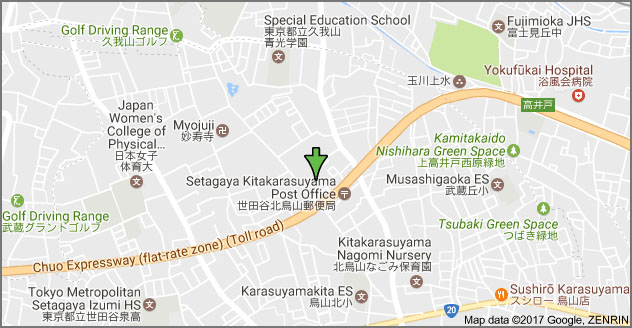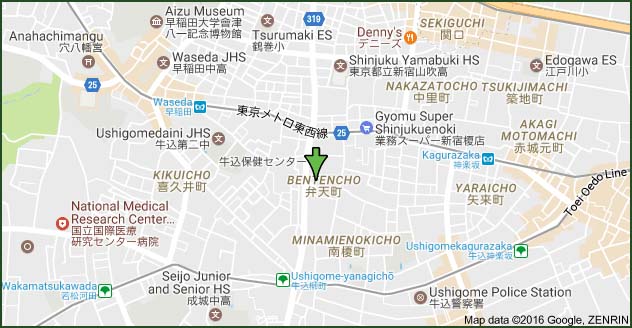[ . BACK to DARUMA MUSEUM TOP . ]
. Kobo Daishi Reijo 弘法大師霊場 Kobo Daishi Henro Pilgrimages in Japan .
. Kanot Henro Pilgrimage 関東八十八ヶ所霊場 .
::::::::::::::::::::::::::::::::::::::::::::::::::::::::::::::::::::::::::::::::::::::::::::::::::::::::::::::::::::::::::::::::::::::::::::::::::::::::::::::::::::::::::::::
Gofunai 御府内八十八ヶ所霊場 88 Henro Temples in Edo
Go-Funai 88kasho - Visiting 88 Temples in the Lord's City
江戸八十八ケ所霊場めぐり Junrei - Pilgrimage in central Tokyo
- Introduction -

This pilgrimage was established in 1755 by Shootoo Oshoo
正等和尚 Shoto Osho (1703-1774).
His grave is at the temple Nr. 31, 多聞院
Tamon-In.
Gofunai or 府内
Funai referred to the part of Edo that was under the jurisdiction of the machibugyoo 江戸町奉行 city magistrate. Fukagawa, Itabashi, Shinagawa, Honjo, Senju and Yotsuya were included.
In Shikoku, all the Henro temples belong to the Koyasan Shingon sect of Buddhism. When the Gofunai route was established in Edo, temples of other Shingon sects participated too. They all have a statue of Kobo Daishi in the compound, surrounded by sacred sand from the Shikoku pilgrim temple of the same number, thus the Edo pilgrims could "step on sacred sand" of Shikoku :
. o-sunafumi, osunafumi お砂踏み stepping on sacred sand .
Some temples have お砂踏の石 a stone memorial, a flat stone to step on with the "Sacred Sand" in mind, or a statue of Kobo Daishi to walk around.
 source : blog.goshuin.net/gofunai
source : blog.goshuin.net/gofunai
The Henro pilgrim is always walking together with Kobo Daishi 二人同行, usually wearing white robes, a hat and a walking stick, symbolizing Kobo Daishi.
The go-eika ご詠歌
chant of the temple is the same as the corresponding to the temple with the same number in Shikoku.
Jippensha Ikku 十返舎一九 (1765–1831) mentiones this pilgrimage as 東都大師巡八十八箇所. He wrote that many people start a pilgrimage to seek healing from an illness or pray to stay healthy until the day they have to die, so as not to become a burden to their family.
Like watching Kabuki theater, going to a pilgrimage in Edo became a kind of hobby for the rich. It is also a way for bereaved people to try and cope with the loss of a loved one. Masaoka Shiki wrote:
その人の足あとふめば風薫る
sono hito no ashiato fumeba kaze kaoru
there is a fragrant breeze
if you can step on the footprints
of a loved one
. Masaoka Shiki 正岡子規 .
.......................................................................
 江戸御府内八十八ヶ所 御朱印を求めて歩く-- 札所めぐりルートガイド
江戸御府内八十八ヶ所 御朱印を求めて歩く-- 札所めぐりルートガイド
::::::::::::::::::::::::::::::::::::::::::::::::::::::::::::::::::::::::::::::::::::::::::::::::::::::::::::::::::::::::::::::::::::::::::::::::::::::::::::::::::::::::::::::
- - - - - Table of contents - - - - -
Henro 阿波(徳島)発心の道場 -- hosshin awakening - Tokushima Awa 23 temples
01 高野山東京別院 Koyasan Tokyo Betsu-In (港区高輪3-15-18) - see below -
. 02 東福寺 Tofuku-Ji / 03 多聞院 Tamon-In .
(中野区江古田3-9-15 - Nakano, Egota) // (世田谷区北烏山4-12-1 - Setagaya, Kitakarasuyama)
. 04 高福院 Kofuku-In / 05 延命院 Enmei-In .
(品川区上大崎2-13-3 - Shinagawa, Kamiosaki) // (港区南麻布3-10-15 - Minato, Minamiazabu)
. 06 不動院 Fudo-In / 07 室泉寺 Shitsusen-Ji .
(港区六本木3-15-4 - Minato, Roppongi) // (渋谷区東3-8-16 - Shibuya, Higashi)
. 08 長遠寺 Choon-Ji / 09 龍巖寺 / 龍岩寺 Ryugan-Ji .
(大田区南馬込5-2-10)- Ota, Minamimagome // (渋谷区神宮前2-3-8 - Shibuya, Jingumae)
. 10 聖輪寺 Shorin-Ji / 11 荘厳寺 Shogon-Ji .
(渋谷区千駄ヶ谷1-13)- Shibuya, Sendagaya // (渋谷区本町2-44-3)- Shibuya, Honmachi
. 12 宝仙寺 Hosen-Ji / 13 龍生院 Ryusho-In .
(中野区中央2-33-3)- Chuo, Nakano // (港区三田2-12-5)- Minato, Mita
. 14 福蔵院 Fukuzo-In / 15 南蔵院 Nanzo-In .
(中野区白鷺1-31-5)Shirasagi, Nakano // (練馬区中村1-15-1) - Nakamura, Nerima)
. 16 三宝寺 Sanpo-Ji / 17 長命寺 Chomei-Ji .
(練馬区石神井台1-15)Shakujiidai, Nerima // (練馬区高野台3-10-3) Takanodai, Nerima
. 18 愛染院 Aizen-In / 19 青蓮寺 Shoren-Ji .
(新宿区若葉2-8-3)Wakaba, Shinjuku // (板橋区成増4-36-2)Narimasu, Itabashi
. 20 鏡照院 Kyosho-In / 21 東福院 Tofuku-In .
(港区西新橋3-14-3)Nishi Shinbashi, Minato // (新宿区若葉2-2)Wakaba, Shinjuku
. 22 南蔵院 Nanzo-In / 23 薬研堀不動院 Yagenbori Fudo-In .
(新宿区箪笥町42)Tansumachi, Shinjuku // (中央区東日本橋2-6-8)Higashinihonbashi, Chuo
..............................................................................................................................................
Henro 土佐(高知)修行の道場 -- shugyo austerities - Kochi Tosa 16 temples
. 24 最勝寺 Saisho-Ji / 25 長楽寺 Choraku-Ji .
(新宿区上落合3-4-12) Kamiochiai, Shinjuku // (日野市程久保8-49-18) Hodokubo, Hin Town
. 26 来福寺 Raifuku-Ji / 27 正光院 Shoko-In .
(品川区東大井3-13-1)Higashiōi, Shinagawa // (港区元麻布3-2-20)Motoazabu, Minato
. 28 霊雲寺 Reiun-Ji / 29 南蔵院 Nanzo-In .
(文京区湯島2-21-6)Yushima, Bunkyo // (豊島区高田1-19-16)Takada, Toshima
. 30 放生寺 Hojo-Ji / 31 多聞院 Tamon-In .
(新宿区西早稲田2-1-14)Nishi Waseda, Shinjuku // (新宿区弁天町100) Bentencho, Shinjuku
. 32 円満寺 Enman-Ji / 33 真性寺 / 眞性寺 Shinsho-Ji .
(文京区湯島1-6-2)Yushima, Bunkyo // (豊島区巣鴨3-21-2) Sugamo, Toshima
. 34 三念寺 Sannen-Ji / 35 根生院 Konsho-In .
(文京区本郷2-15-6)Hongo, Bunkyo // (豊島区高田1-34-6)Takada, Toshima
. 36 薬王院 Yakuo-In / 37 萬徳院 Mantoku-In .
新宿区下落合4-8-2)Shimoochiai, Shinjuku // (江東区永代2-37-22)Eitai, Koto
. 38 金乗院 Konjo-In / 39 真成院 Shinjo-In .
(豊島区高田2-12-3)Takada, Toshima // (新宿区若葉2-7-8)Wakaba, Shinjuku
..............................................................................................................................................
 大江戸めぐり 御府内八十八ヶ所 Walking in Old Edo
大江戸めぐり 御府内八十八ヶ所 Walking in Old Edo
和田信子
..............................................................................................................................................
Henro 伊予(愛媛)菩提の道場 -- bodai enlightenment - Ehime Iyo 26 temples
. 40 普門院 Fumon-In / 41 密蔵院 Mitsuzo-In .
(江東区亀戸3-43-3)Kameido, Koto // (中野区沼袋2-33-4)Numabukuro, Nakano
. 42 観音寺 Kannon-Ji / 43 成就院 Joju-In - 百観音成就院 Hyakkannon .
(台東区谷中5-8-28)Yanaka, Taito //(台東区元浅草4-8-12)Motoasakusa, Taito
. 44 顕性寺 Kensho-Ji / 45 観蔵院 Kanzo-In .
(新宿区須賀町13-5)Sugacho, Shinjuku // (台東区元浅草3-18-5)Motoasakusa, Taito
. 46 弥勒寺 Miroku-Ji / 47 城官寺 Jokan-Jii .
(墨田区立川1-4-13)Tatejawa, Sumida // (北区上中里1-42-8)Kaminakazato, Kita
. 48 禅定院 Zenjo-In / 49 多宝院 / 多寶院 Taho-In .
(中野区沼袋2-28-2)Numabukuro, Nakano // 台東区谷中6-2-35)Yanaka, Taito
. 50 大徳院 Daitoku-In / 51 延命院 nimei-In .
(墨田区両国2-7-13)Ryogoku, Sumida // (台東区元浅草4-5-2)Motoasakusa, Taitō
. 52 観音寺 Kannon-Ji / 53 自性院 Jisho-In .
(新宿区西早稲田1-7-1)Nishiwaseda, Shinjuku //(台東区谷中6-2-8)Yanaka, Taito
. 54 新長谷寺 Shin Hasedera / 55 長久院 Chokyu-In .
(豊島区高田2-12-3)Takada, Toshima // (台東区谷中6-2-16)Yanaka, Taito
. 56 与楽寺 Yoraku-Ji / 57 明王院 Myoo-In .
(北区田端1-25-1)Tabata, Kita // (台東区谷中5-4-2)Yanaka, Taito
. 58 光徳院 Kotoku-In / 59 無量寺 Muryo-Ji .
(中野区上高田5-18-3) Kamitakada, Nakano // (北区西ヶ原1-34-8)Nishigahara, Kita
. 60 吉祥院 Kissho-In / 61 正福院 Shofuku-In .
(台東区元浅草2-1-14)Motoasakusa, Taito // (台東区元浅草4-7-21)Motoasakusa, Taito
. 62 威光院 Iko-In / 63 観智院 Kanchi-In .
(台東区寿2-6-8)Kotobuki, Taito //(台東区谷中5-2-4)Yanaka, Taito
. 64 加納院 Kano-In / 65 大聖院 Daisho-In .
(台東区谷中5-8-5)Yanaka, Taido // (港区三田4-1-27)Mita, Minato
..............................................................................................................................................
Henro 讃岐(香川)涅槃の道場 -- nehan entering Nirwana - Kagawa Sanuki 23 temples
 . 66 東覚寺 Togaku-Ji / 67 真福寺 Shinpuku-Ji .
. 66 東覚寺 Togaku-Ji / 67 真福寺 Shinpuku-Ji .
(北区田端2-7-3)Tabata, Kita // (港区愛宕1-3-8)Atago, Minato
. 68 永代寺 Eitai-Ji / 69 宝生院 Hosho-In .
(江東区富岡1-15-1)Tomioka, Koto // (港区三田4-1-29)Mita, Minato
. 70 禅定院 Zenjo-In / 71 梅照院 Baisho-In Arai Yakushi .
(練馬区石神井町5-19-10) Shakuji-I, Nerima // (中野区新井5-3-5) Arai, Nakano
. 72 寿 不動院 Kotobuki Fudo-In / 73 東覚寺 / 東覺寺 Togaku-Ji - 亀戸不動 Kameido Fudo .
(台東区寿2-5-2)Kotobuki, Taito // (江東区亀戸4-24-1)Kameido, Koto
. 74 法乗院 Hojo-In / 75 威徳寺 Itoku-Ji .
(江東区深川2-16-3)Fukagawa, Koto (Fukagawa Enma) // 港区赤坂4-1-10)Akasaka, Minato (Akasaka Fudo)
. 76 金剛院 Kongo-In / 77 仏乗院 Butsujo-In .
(豊島区長崎1-9-2)Nagasaki, Toshima // (神奈川県秦野市蓑毛957-13)
Kanagawa prefecture, Hadano, Minoge
. 78 成就院 Joju-In / 79 専教院 Senkyo-In .
(台東区東上野3-32-15)Higashi-Ueno, Taito // (文京区小日向3-6-10)Kohinata, Bunkyo
. 80 長延寺 Choen-Ji / 81 光蔵院 Kozo-In .
(港区三田4-1-31)Mita, Minato // (港区赤坂7-6-68)Akasaka, Minato
. 82 龍福院 Ryufuku-In / 83 蓮乗院 Renjo-In .
(台東区元浅草3-17-2)Motoasakusa, Taito // (新宿区若葉2-8-6)Wakaba, Shinjuku
. 84 明王院 Myo-O-In / 85 観音寺 Kannon-Ji .
(港区三田4-3-9)Mita, Minato // (新宿区高田馬場3-37-26)Takadanobaba, Shinjuku
. 86 常泉院 Jozen-In / 87 護国寺 Gokoku-Ji .
(文京区春日1-9-3)Kasuga, Bunkyo //(文京区大塚5-40-1)Otsuka, Bunkyo
. 88 文殊院(杉並区和泉4-18-17))Monju-In (Suginami, Izumi) .
..............................................................................................................................................
After the Meiji restoration, earthquakes and fires some temples were relocated outside of the central area, to make room for the modern city development.
Therefore the temples are now located here and there in Tokyo. This is one suggestion for a route:
1-85-81-84-62-43-61-82-32-34-86-71-31-22-58-48-77-65-69-80-27-19-20-67-13-74-68-73-40-46-50-51-45-72-41-60-78-49-53-55-70-63-57-64-42-56-66-59-47-33-35-28-79-87-76-54-52-30-38-15-17-16-14-12-11-3-24-2-36-29-23-37-25-21-18-83-39-26-44-10-9-75-6-5-7-4-8-88
It is only important to start the Edo Gofunai pilgrimage at temple number 01 and end at temple number 88.
..............................................................................................................................................
reference : tesshow.jp/funai88_index
- reference for stamps : goshuin.blog.jp/tag -
御府内八十八ヶ所の札所番号にはどういう意味があるか?
- reference - blog.goshuin.net
List with names, chants, adresses . . . 御府内八十八ヶ所
- reference : onsen.onsenzuki.iinaa.net/gosyuin -
With long explanations 端書き
- reference : biglobe.ne.jp/~karasumoridounin/a0toukyouohenroindex -
 shuinchoo 朱印帳, nookyoocho 納経帳 Nokyo-cho stamp book of the pilgrimage
shuinchoo 朱印帳, nookyoocho 納経帳 Nokyo-cho stamp book of the pilgrimage
::::::::::::::::::::::::::::::::::::::::::::::::::::::::::::::::::::::::::::::::::::::::::::::::::::::::::::::::::::::::::::::::::::::::::::::::::::::::::::::::::::::::::::::
Gofunai 01 - Kōyasan Tōkyō Betsuin 高野山東京別院 Koyasan Tokyo Betsu-In
"Koyasan Tokyo Branch Temple"
港区高輪3-15-18 - Minato-Ku
Takanawa
 source : blog.goshuin.net/gofunai
source : blog.goshuin.net/gofunai
Its main statue is of
Kukai Kobo Daishi, now placed in the hall Henjooden 遍照殿
Henjo-Den.
Around 1600 the temple was located at 浅草日輪寺 Asakusa Nichirin-Ji as a place for the local Shingon priests to study.
In 1655, it was relocated by the Bakufu government to Nihon Enoki 二本榎 in 芝 Shiba.
In 1673, it was re-named 高野山江戸在番所高野寺
Koyasan Edo Zaibansho Koya-Ji, but lost in a fire in 1702.
It was re-built in 1674 and now became the first temple of the official Bakufu Henro pilgrimage, Gofunai.
In 1927, it got its present name, 高野山東京別院. The main hall was constructed in 1988.
- reference source : www.musubidaishi.jp -
 source : panoramio - 遠藤勝久
source : panoramio - 遠藤勝久
- ご詠歌
- chant of the temple :
霊山の釈迦の御前に巡り来て よろずの積みも 消え失せにけり
ryoozen no Shaka nomi mae ni megurikite yorozu no tsumi mo kieuse ni keri
- 朱印
- stamp of the temple :

It is also part of the pilgrimages:
. 関東八十八箇所 - 特別霊場 - Kanto 88 Henro Temples - Special Temple .
. 江戸三十三箇所 Edo Sanjusan Kannon Pilgrimage - Nr. 29 .
. Ryoozenji 霊山寺 Ryozen-Ji - Shikoku Henro Nr. 01 .
. 高輪銭洗不動 Takanawa Zeniarai Fudo. .
東京都港区高輪一丁目 - 黄梅院 Kobai-In Minato Ward Takanawa
. Takanawa district 高輪, Takanawadai 高輪台 in Edo .
In the temple garden is a stone memorial of this haiku by
the famous Geisha
Takehara Han 武原はん (1903-1998) :
喜びを兼ねて舞うや宵の春
yorokobi o kanete mau ya yoi no haru
I dance
to express my happiness -
this spring night
Tr. Gabi Greve
:::::::::::::::::::::::::::::::::::::::::::::::::::::::::::::::::::::::::::::::::::::::::::::::::::::::::::::::::::::::::::::::::::::::::::::::::::::::::::::::::::::::::::::
 東京お遍路 大江戸めぐり ― 江戸御府内八十八ヶ所
東京お遍路 大江戸めぐり ― 江戸御府内八十八ヶ所
林 えり子 (著), 相原 健二 (イラスト)
Henro Pilgrims in Tokyo, Walking along Old Edo
::::::::::::::::::::::::::::::::::::::::::::::::::::::::::::::::::::::::::::::::::::::::::::::::::::::::::::::::::::::::::::::::::::::::::::::::::::::::::::::::::::::::::::::
Gofunai Bikō 御府内備考 Gofunai Biko - Notes on Edo
 - quote -
Funai Biko
- quote -
Funai Biko
The only geographical booklet on Edo compiled by the Edo Shogunate.
Also known by the separate title
Gofunai Biko. This work was organized to serve as reference for the 御府内風土記
Gofunai Fudoki to be compiled by the Tokugawa Shogunate, and was compiled in 2 parts consisting of a principal part and a sequel from 1826 to 1830. The 145 volumes of the main part contain articles on Edo Castle, streets, historic spots, etc.
The 147 volumes of the sequel are also known as the
Gofunai Jisha Biko and contain information on the origins and historic associations of temples and shrines. The Gofunai Fudoki was lost in the fire at the imperial palace in 1872, however the Gofunai Biko escaped intact.
- reference source : ndl.go.jp/landmarks -
. Welcome to Edo 江戸 ! - The Edopedia .
::::::::::::::::::::::::::::::::::::::::::::::::::::::::::::::::::::::::::::::::::::::::::::::::::::::::::::::::::::::::::::::::::::::::::::::::::::::::::::::::::::::::::::::
. Fudō Myō-ō, Fudoo Myoo-Oo 不動明王 Fudo Myo-O
Acala Vidyârâja - Vidyaraja – Fudo Myoo .
. Pilgrimages to Fudo Temples 不動明王巡礼
Fudo Myo-O Junrei - Introduction - .
The Five Great Wisdom Kings, Godai Myo-O - 五大明王
. The Five Great Elements of the Universe - 地水火風空の五大 .
::::::::::::::::::::::::::::::::::::::::::::::::::::::::::::::::::::::::::::::::::::::::::::::::::::::::::::::::::::::::::::::::::::::::::::::::::::::::::::::::::::::::::::::
. 四国お遍路さん Pilgrims in Shikoku . -
General Information
Koya San in Wakayama
. Kobo Daishi Kukai 弘法大師 空海 .
(Kooboo Daishi, Kuukai)
. Gyoki Bosatsu 行基菩薩 (668 - 749) Saint Gyōki .
Haiku and Henro:
.... . The Haiku Henro Pilgrimage
::::::::::::::::::::::::::::::::::::::::::::::::::::::::::::::::::::::::::::::::::::::::::::::::::::::::::::::::::::::::::::::::::::::::::::::::::::::::::::::::::::::::::::::
 . Join the Gofunai Friends on Facebook ! .
. Join the Gofunai Friends on Facebook ! .

::::::::::::::::::::::::::::::::::::::::::::::::::::::::::::::::::::::::::::::::::::::::::::::::::::::::::::::::::::::::::::::::::::::::::::::::::::::::::::::::::::::::::::::
. Japan - Shrines and Temples - ABC .
[ . BACK to DARUMA MUSEUM . TOP . ]
[ . BACK to WORLDKIGO . TOP . ]
- - - - - #henrogofunai #gofunaihenro #gofunaiedo #gofunaibiko #edohenro #edopilgrims #gofunaiabc - - - - -
::::::::::::::::::::::::::::::::::::::::::::::::::::::::::::::::::::::::::::::::::::::::::::::::::::::::::::::::::::::::::::::::::::::::::::::::::::::::::::::::::::::::::::::















































